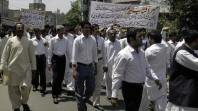The Thar area of Sindh, being a much smaller part of the vast desert that stretches well into India, is no stranger to drought. Rain rarely ventures along this way, there being no high mountain ranges to hem in the life-giving monsoon, and sometimes the interval of waiting for the parched earth may even be counted in years. Today, the drought-like conditions prevailing since 2011 have led to a massive human tragedy, and famine and starvation has so far killed 193 children under the age of five, not to mention the staggering livestock losses. Unfortunately, apart from the cruelty of nature in this disaster, one is also constrained to blame the Sindh government and its callous negligent attitude, before and initially during the whole affair. After all, the tragedy had been brewing for a long time and preventive steps taken in time could have mitigated the present suffering and all the heartbreak.
The Raj had a solution
During the Raj, a special rule applied to Thar region. If no rains fell by August 15, the government promptly announced a drought emergency in the area and officially declared the region as a calamity-hit area. This was logical, as rainfall, after this cutoff date, precludes further sowing and there can be no crop, grass or other vegetation in the region until the next monsoon.
The terrible conditions prevailing in the surrounding villages were starkly highlighted by that scourge of governmental incompetence and apathy, the vibrant, sometimes excessively so, electronic media. Thereafter the government was forced to wake from its deep slumber. After officially declaring Thar to be a drought hit area, the Sindh government and departments such as the Provincial Disaster Management Authority (PDMA) and the Food and Health departments started relief operations, which included selling wheat at half price to the victims, providing sufficient supply of medicines to public hospitals and hospitalizing those worst affected, while also locating the surviving livestock to safer places. As is the case in disasters of any nature, the Army’s doctors and relief goods were the first on the scene.
There was insufficient rain in the year 2013 in Thar region, except in the Nangarparkar area and on August 19, the authorities duly declared it as a drought affected area.
“Unfortunately, though the Sindh government announced the drought in Thar, but it was not officially notified, therefore we were unable to start relief operation in the region,” according to Akhlaque Ahmed Qureshi, the director operations, PDMA, Sindh. Actually, the drought warning should have been notified in 2013 and the relief work started immediately.
Sindh govt. apathy
However, the Sindh government did send 14,000 bags of wheat in late August 2013, as relief for 1.6 million population of the district!
“As per rules, government was supposed to send sufficient quantity of wheat on half price for a year, but they sent wheat for only one month and did not issue the next lot,” said a depot owner in Mithi, the district headquarters of Thar.
PML-N leader and former chief minister Sindh Arbab Ghulam Rahim, who is also a native of Tharparkar, alleged that PPP-led Sindh government deliberately delayed relief operations in Thar. “They wanted to use wheat distribution as a political bribe during the Local Bodies elections, which couldn’t be held due to ban by the judiciary,” he maintained.
After extensive coverage by the mainstream media of the drought and deaths of children, the Sindh government was forced as a face-saver to remove the DC of Tharparkar, and the concerned minister, both incidently the sons of PPP veteran leader Makhdoom Amin Fahim. PPP insiders state that they were sacked on the directive of Bilawal Bhutto, but after the intervention of Asif Zardari, both were restored.
Not a new phenomenon
Drought is not a new phenomenon in the Thar Desert. Spread over 20,000 square kilometers along the Indian border in eastern Sindh, the region has witnessed 12 severe, eight moderate and 11 mild droughts since 1965. There were severe droughts in 1968, 1978, 1985, 1986, 1987, 1995, 1996, 1999, 2001, 2004, 2005 and 2007, out of which 1985 and 1999 were quite severe, but the present drought is the deadliest so far.
The situation can also prove deadly in other ways, as the livestock in Thar, which according to official data numbers 7.3 million, including goats, sheep, camel and cows, accounts for 68 percent of Sindh’s total livestock.
In times of acute drought, the local herdsmen take their livestock to the north, in the barrage areas on the country’s largest river, the Indus, where they spend months searching for fodder for their livestock and livelihood for themselves by working as temporary agriculture workers, but floods often preempt even this option of last resort.
In 2013, there was nearly normal rainfall in the Nangarparkara, where the majority of Thar’s livestock is to be found and most of the affected herdsmen migrated instead of the barrage area, as some fodder was available there. “A small area in Nagarparkar experienced rains and when everyone migrated there, the fodder ran out after only three months causing a stampede to the barrage area, but by then it was too late,’’ remarked a social activist of Mithi town.
Children, the main victim
The first victims of the drought were the peacocks and by December 2013, hundreds of the beautiful birds had died in the Thar region. It was wrongly claimed at the time that they has succumbed to a disease. Also, nearly 30 percent of the total sheep population of the region has died in recent months.
Among locals, minor children were the worst victims of the food shortage, as their mothers were unable to feed them properly. Most people of Thar are dependent for their routine food on their livestock, but when the animals started dying, it inevitably affected their food chain.
The Sindh government belatedly organized relief operations under the supervision of PPP leader and coordinator to the CM Sindh, Taj Haider. Wheat distribution began and special teams of doctors were sent to the district headquarters while the Livestock Department started vaccinating the cattle in the district. Many NGOs, political parties, paramilitary forces, government departments and even banned religious organizations set up their camps in Mithi town.
One can still see long lines of empty tents with banners bearing the legend, “Relief Camps”, hanging on them at the Kashmir Chowk, the main roundabout in the town, but only for the media’s benefit. The residents even witnessed the vehicles of different public departments, including National Disaster Management Authority (NDMA), PDMA, the Meteorology Department and even NADRA, which they had never seen before.
But the locals are far from satisfied with relief operations so far. They complain that most of the relief work for the drought, which is spread over an area of 20,000 square kilometers and comprises around 2,300 traditional hamlets, villages and towns, remained limited to Mithi.
‘You can’t treat hunger with vaccine’
Though the government has planned wheat distribution for the human population, but the residents demand a complete package, which includes food and water for humans, and fodder and vaccines for the livestock and also a permanent solution to the destructive impact of future droughts.
In the present instance, it is officially claimed that out of a total of 7.3 million animals, over 2.2 million have been vaccinated till March 15, but the locals contest this remedy.
“You can’t treat hunger with vaccine,” said a herdsman of Peeloro village in Tharparkar, adding that the animals are dying of not disease, and they need fodder, not vaccinations.
The real solution to the repeated drought conditions lies in the setting up of industries in the region, creation of jobs for the locals, provision of freshwater, a fodder bank for livestock to fall back on during droughts and their timely vaccinations, among others.
The writer is a journalist based in Karachi. He tweets @AmarGuriro





















